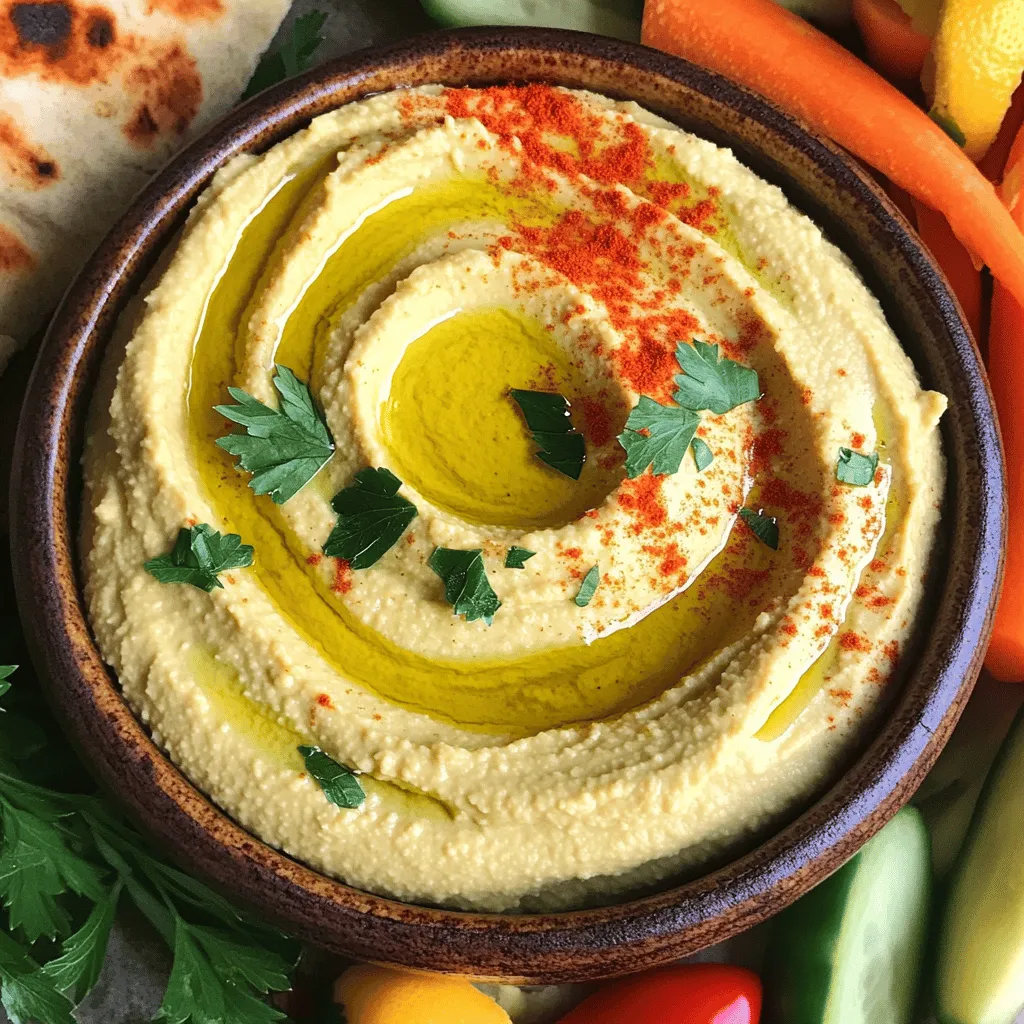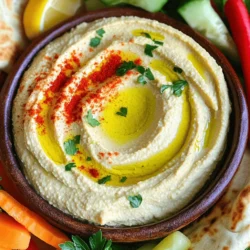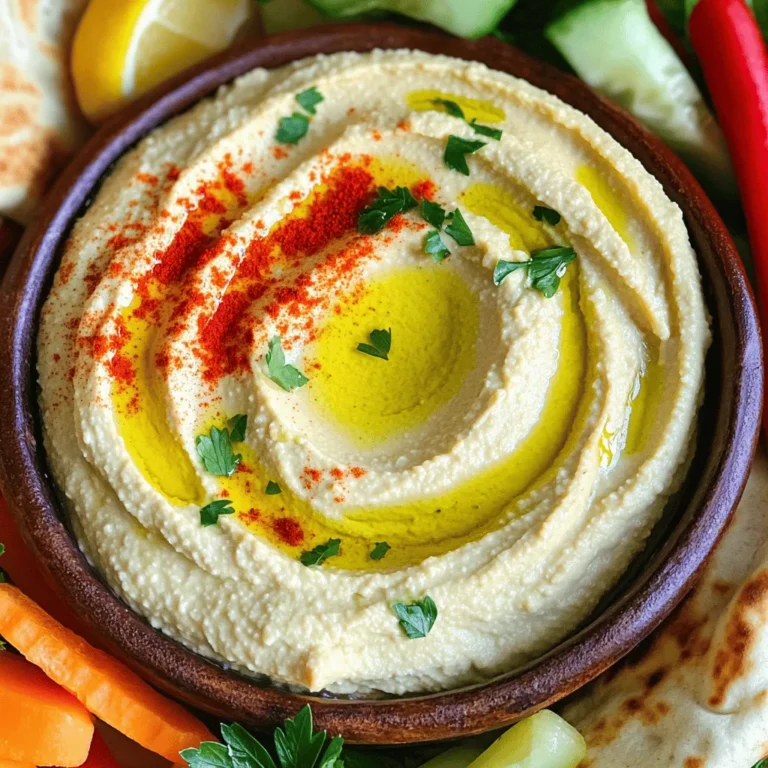If you crave a simple yet delightful dip, you’re in for a treat! My classic hummus recipe is packed with flavor and easy to make. You’ll learn about each ingredient’s role, blending tips for that perfect smoothness, and exciting variations to spice things up. Get ready to impress your friends and family with a tasty treat that’s both homemade and satisfying. Let’s dive in and create some hummus magic together!
Ingredients
List of Ingredients
– 1 can (15 oz) chickpeas, drained and rinsed
– 1/4 cup tahini
– 2 tablespoons olive oil
– 1 clove garlic, minced
– 2 tablespoons fresh lemon juice
– 1/2 teaspoon ground cumin
– Salt, to taste
– 3 tablespoons cold water
– Paprika, for garnish
– Fresh parsley, chopped, for garnish
Importance of Each Ingredient
Each ingredient in this hummus plays a key role. Chickpeas are the base. They provide protein and fiber. Tahini adds a creamy texture and a nutty flavor. Olive oil gives richness. Garlic brings a bold taste. Lemon juice adds brightness and balance. Ground cumin offers warmth and depth. Salt enhances all flavors. Water helps reach the right texture. Paprika and parsley make it look pretty and fresh.
Measuring Tips
Use measuring cups and spoons for accuracy. When measuring tahini, it often sticks. To help, use a spatula to scrape it out. For olive oil, pour it into the spoon slowly. This helps avoid spills. When measuring lemon juice, roll the lemon first. This releases more juice. For salt, start with a little. You can always add more if needed.
Step-by-Step Instructions
Preparation Process
Start by gathering all your ingredients. You need chickpeas, tahini, olive oil, garlic, lemon juice, ground cumin, salt, and cold water. Drain and rinse the chickpeas. This step helps remove excess salt and makes your hummus smoother. Place the chickpeas in your food processor along with tahini, minced garlic, olive oil, lemon juice, ground cumin, and a pinch of salt.
Blending Techniques for Smoothness
Blend the mix on high speed for about one minute. This action breaks down the chickpeas and creates a creamy base. Stop and scrape down the sides of the bowl. This way, all the ingredients blend evenly. Add cold water, one tablespoon at a time. Blend after each addition until your hummus reaches the desired smoothness.
Adjusting the Consistency
Taste the hummus to check the flavor. If it needs more zing, add more lemon juice or garlic. If it is too thick, blend in a bit more cold water. If it is too runny, add a little more tahini or chickpeas. The goal is to find a balance that suits your taste.Enjoy your delicious hummus!
Tips & Tricks
Achieving the Perfect Texture
To get smooth hummus, use a food processor. Start with well-drained chickpeas. Blend them with tahini, garlic, and olive oil. Add water slowly for the right thickness. If it feels too thick, just add more water. Scrape the sides of the bowl often. This helps blend everything well. Aim for a creamy and fluffy texture.
Flavor Enhancements
You can boost flavor with a few simple tricks. Try adding more lemon juice for brightness. A dash of ground cumin adds warmth. If you like spice, add a pinch of cayenne pepper. Roasted garlic gives a sweet, deep taste. Fresh herbs like parsley or cilantro also add freshness. Taste and adjust to find your favorite balance.
Serving Suggestions
Hummus is great on its own or with sides. Serve it with warm pita bread. Fresh veggies like carrots and cucumbers work well too. You can make a mezze platter with olives and cheese. Drizzle extra olive oil on top for a nice touch. Garnish with paprika and parsley for color. Try different dips to make it fun!

Variations
Spicy Hummus Options
You can add heat to your hummus with some easy changes. Start by mixing in 1-2 teaspoons of cayenne pepper or red pepper flakes. If you enjoy a smoky flavor, try adding smoked paprika. For a fresh twist, blend in a jalapeño pepper, seeds removed, for added spice. Each of these options gives your hummus a bold kick.
Herb-Infused Variants
Adding fresh herbs can elevate your classic hummus. Basil, cilantro, or dill can bring a new flavor. Just chop about 1/4 cup of your chosen herb. Blend it in with the other ingredients for a fresh taste. You can also use dried herbs, like oregano or thyme, if fresh herbs are not available.
Nut-Free Alternatives
If you need a nut-free option, simply replace tahini. Try using sunflower seed butter or pumpkin seed butter instead. These alternatives still offer a creamy texture and nutty taste. They keep your hummus delicious and safe for those with nut allergies.
Each variation allows you to customize your hummus. Try them out to find your favorite twist!
Storage Info
How to Store Hummus
To keep hummus fresh, store it in an airtight container. Make sure the lid seals well. You can also drizzle a little olive oil on top. This oil helps keep the hummus moist. If you don’t have a lid, use plastic wrap. Press it down on the hummus to reduce air contact.
Shelf Life of Homemade Hummus
Homemade hummus lasts about 4 to 7 days in the fridge. Always check for off smells or changes in texture. If it looks dry, you might need to add a bit of water or olive oil. If you see mold, throw it away. It’s better to be safe than sorry.
Reheating and Reviving Tips
You usually don’t need to reheat hummus. It tastes great cold. If your hummus thickens in the fridge, simply add cold water. Stir well to bring it back to life. You can also use a food processor for a creamier texture. Just don’t forget to taste and adjust the seasonings after reviving. Enjoy your creamy garlic lemon hummus with your favorite snacks!
FAQs
How can I make hummus creamier?
To make hummus creamier, add more tahini or olive oil. You can also use cold water. Start with a tablespoon and blend. This helps create a smooth texture. If it’s still thick, add more water slowly. Always scrape down the sides of the bowl when blending. This step ensures even mixing.
Can I use dried chickpeas instead of canned?
Yes, you can use dried chickpeas! Soak them overnight in water. Drain and rinse them before cooking. Boil them until tender, which takes about 1 to 2 hours. Use the cooked chickpeas in the recipe as usual. Just remember, dried chickpeas need more time and planning.
What can I serve with hummus?
You can serve hummus with many tasty options. Try pita bread, fresh veggies, or crackers. It also pairs well with grilled meats. Some people enjoy hummus on sandwiches or wraps. You could even add it to a mezze platter for a fun mix of flavors.
Can I freeze hummus?
Yes, you can freeze hummus! Place it in an airtight container. Leave some space at the top for expansion. It can last up to three months in the freezer. To eat, thaw it in the fridge overnight. You may need to stir it well before serving. This keeps it fresh and tasty.
This post covered key ingredients for your hummus, measuring tips, and preparation steps. You learned about blending techniques to achieve smoothness and adjusting for the right consistency. Tips on texture, flavor enhancements, and serving ideas added excitement. Variants like spicy hummus and nut-free options expand your choices. Finally, we discussed how to store hummus, its shelf life, and reheating methods.
Now, you have all the tools needed to master this tasty dip. Enjoy creating your own hummus!


